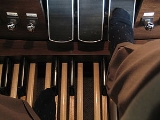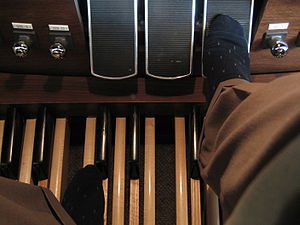
Crescendo pedal
Encyclopedia

Pipe organ
The pipe organ is a musical instrument that produces sound by driving pressurized air through pipes selected via a keyboard. Because each organ pipe produces a single pitch, the pipes are provided in sets called ranks, each of which has a common timbre and volume throughout the keyboard compass...
s (as well as digital organs), either partially or fully recessed within the organ console
Organ console
thumb|right|250px|The console of the [[Wanamaker Organ]] in the Macy's department store in [[Philadelphia]], featuring six manuals and colour-coded stop tabs....
. The crescendo pedal incrementally activates stops
Organ stop
An organ stop is a component of a pipe organ that admits pressurized air to a set of organ pipes. Its name comes from the fact that stops can be used selectively by the organist; some can be "on" , while others can be "off" .The term can also refer...
as it is pressed forward and removes stops as it is depressed backward. The addition of stops, in order from quietest to loudest, creates the effect of a crescendo
Crescendo
-In music:*Crescendo, a passage of music during which the volume gradually increases, see Dynamics * Crescendo , a Liverpool-based electronic pop band* "Diminuendo and Crescendo in Blue", one of Duke Ellington's longer-form compositions...
(and, likewise, a diminuendo, when the stops are retired). The crescendo pedal is located directly above the pedalboard
Pedalboard
A pedalboard is a keyboard played with the feet that is usually used to produce the low-pitched bass line of a piece of music...
, to the right of any expression pedal
Expression pedal
An expression pedal is an important control found on many organs and synthesizers, as well as in the pedal steel guitar, that allows the volume of the sound to be manipulated...
s that may be present. In actual use, the operation of the crescendo pedal usually does not move the draw knobs or stop tabs on the console; the stops are electronically activated inside the organ. Often an indicator light or lights will be present on the console to inform the organist of when the crescendo pedal is activated and how far it is engaged.
The earliest type of automatic crescendo device was the Rollschweller (German for "roll-sweller"), seen in large romantic organs of the nineteenth century, almost exclusively in Germany
Germany
Germany , officially the Federal Republic of Germany , is a federal parliamentary republic in Europe. The country consists of 16 states while the capital and largest city is Berlin. Germany covers an area of 357,021 km2 and has a largely temperate seasonal climate...
. It consists of a wheel and axle, which would be horizontally mounted directly above the pedalboard. When kicked forward by the organist, the wheel would spin forward on its axle, activating a mechanism that would add stops to the registration. Likewise, kicking the wheel in reverse would remove stops. The Rollschweller is constructed so that it may be kicked forward or backward indefinitely. This gives the device a much longer field of operation than the modern crescendo pedal, thus making the dynamic change more smooth and gradual. It is especially helpful and appropriate in the playing of the organ works of Max Reger
Max Reger
Johann Baptist Joseph Maximilian Reger was a German composer, conductor, pianist, organist, and academic teacher.-Life:...
, Franz Liszt
Franz Liszt
Franz Liszt ; ), was a 19th-century Hungarian composer, pianist, conductor, and teacher.Liszt became renowned in Europe during the nineteenth century for his virtuosic skill as a pianist. He was said by his contemporaries to have been the most technically advanced pianist of his age...
, and Sigfrid Karg-Elert
Sigfrid Karg-Elert
Sigfrid Karg-Elert was a German composer of considerable fame in the early twentieth century, best known for his compositions for organ and harmonium.-Biography:...
, who all wrote for organs that featured a Rollschweller.
As the use of electricity
Electricity
Electricity is a general term encompassing a variety of phenomena resulting from the presence and flow of electric charge. These include many easily recognizable phenomena, such as lightning, static electricity, and the flow of electrical current in an electrical wire...
caught on in the twentieth century, organ builders began to apply it to their instruments, electrifying the key action and the stop action as well as the expression pedals. An electrically-operated crescendo pedal resembling an expression pedal was invented and mounted to the right of the expression pedals. The order in which the stops were activated by the crescendo pedal was set by the organ builder and could not be modified by the organist. This was the case until the later part of the twentieth century, when computerized devices were incorporated into console design, allowing greater customization of registration through more sophisticated combination action
Combination action
A combination action is a system designed to capture specific organ registrations to be recalled instantaneously by the player while he is playing. Because of this, it is also referred to as a capture system. It usually consists of several numbered pistons situated in the space between the manuals...
s. As a result, in organs with these devices, the stops controlled by the crescendo pedal are usually customizable, as is the order in which they are activated.
Reed organ
Reed organ
A reed organ, also called a parlor organ, pump organ, cabinet organ, cottage organ, is an organ that generates its sounds using free metal reeds...
s and harmonium
Harmonium
A harmonium is a free-standing keyboard instrument similar to a reed organ. Sound is produced by air being blown through sets of free reeds, resulting in a sound similar to that of an accordion...
s of the late 19th and early 20th centuries often had a similar mechanism to a crescendo pedal. Since the player's feet were needed to pedal the bellows that provided the wind for the instrument, the mechanism was operated by a 'paddle' lever moved by one of the player's knees (the paddle being located under the keyboard). Usually this was called a 'full organ pedal', as it did not gradually engage ranks of stops in the manner of a true crescendo pedal, but simply engaged all the stops (and usually any octave couplers fitted to the instrument) when operated, with no progressive action.

